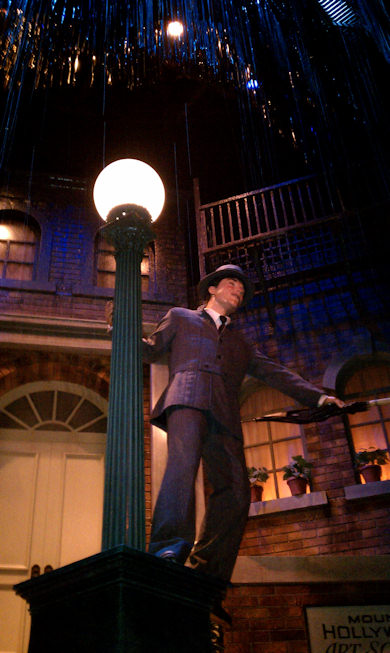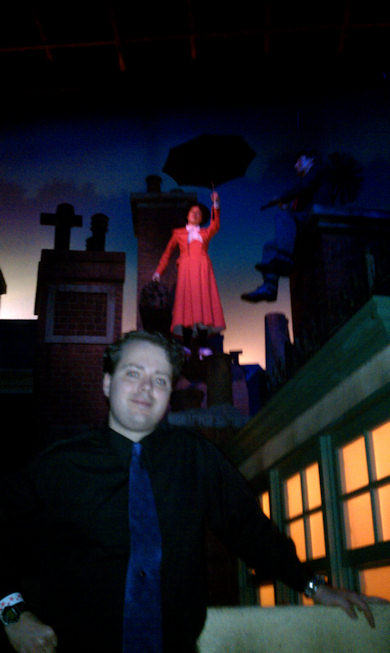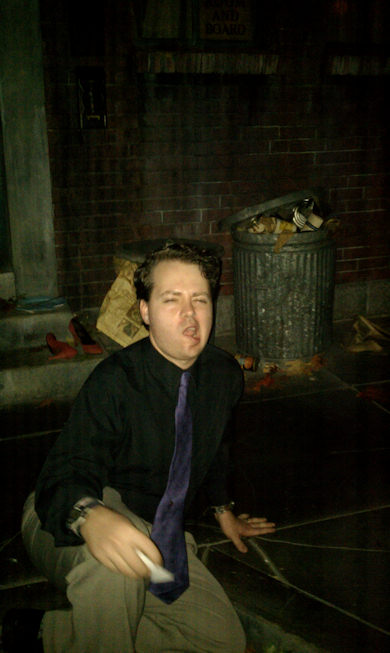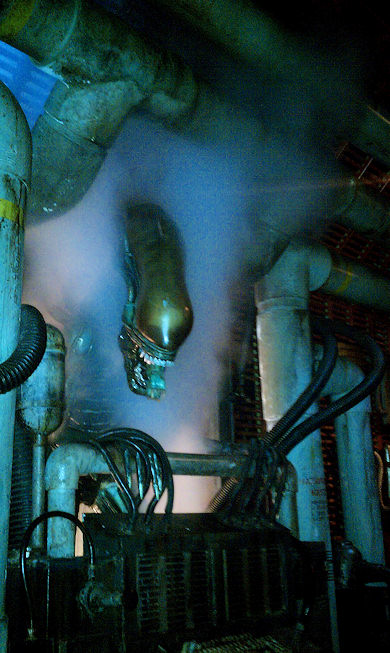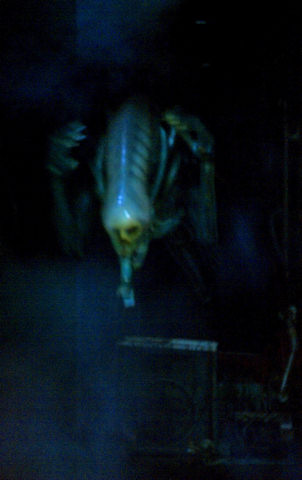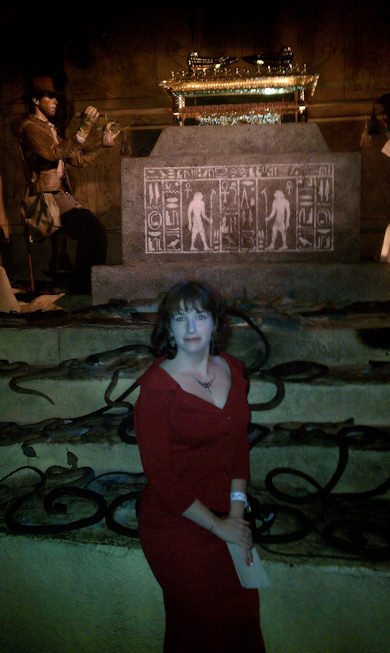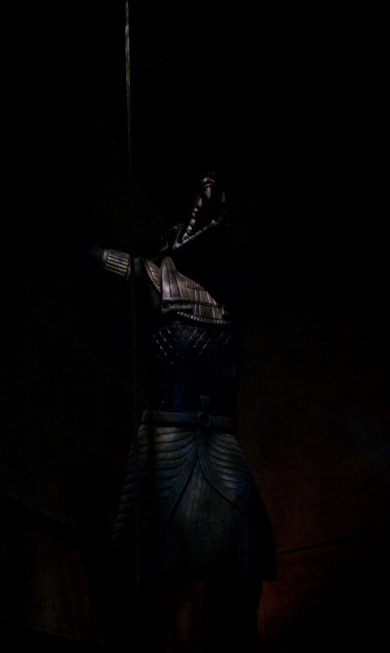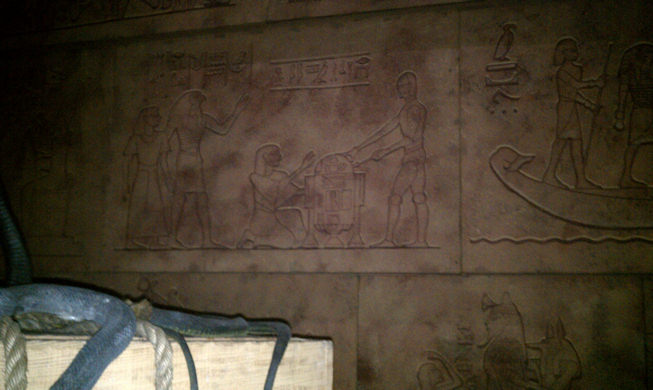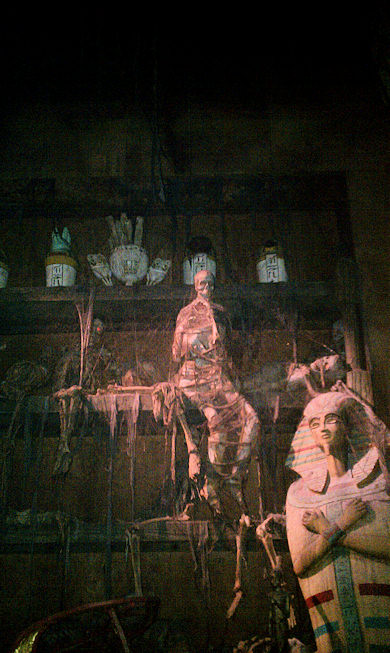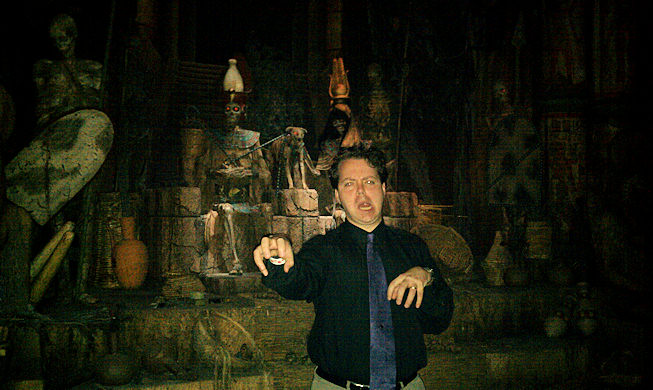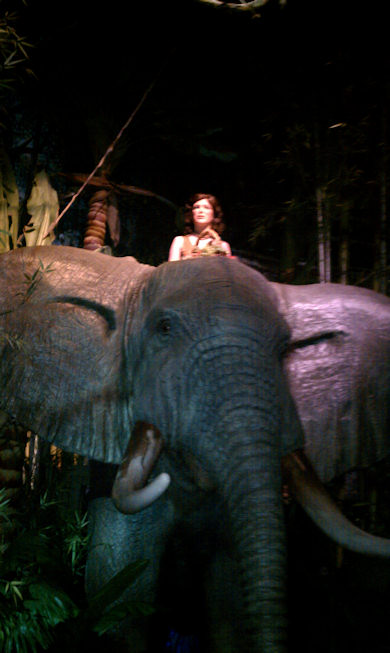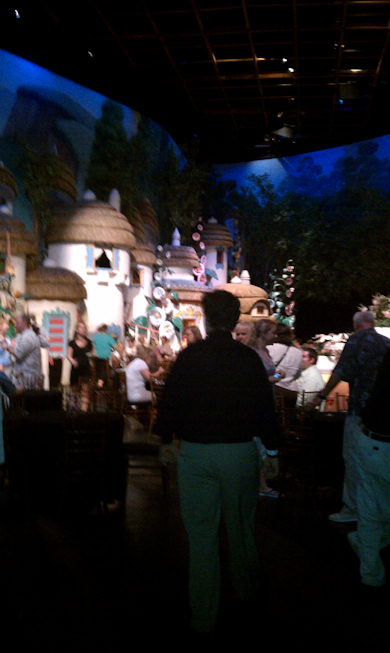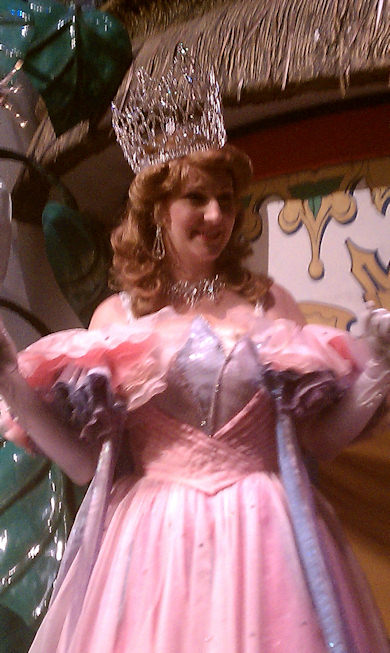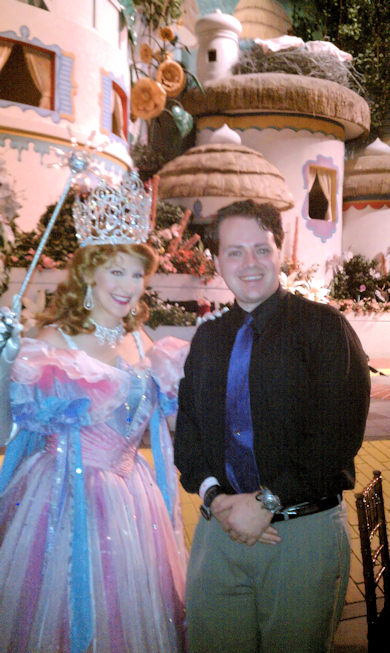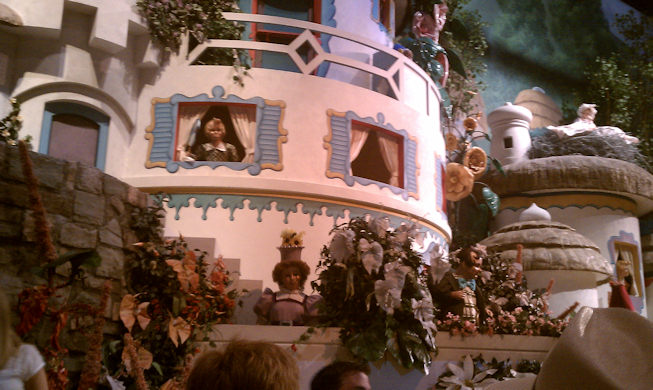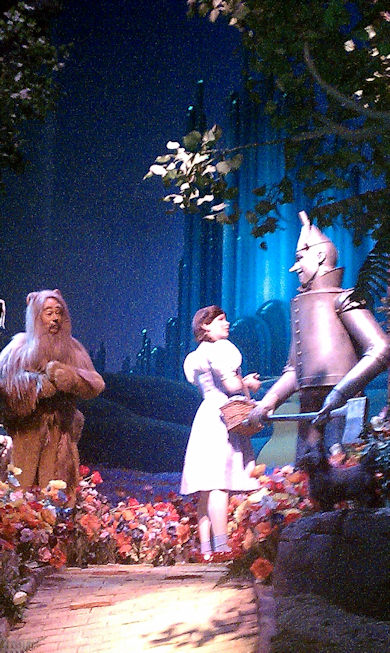I hadn’t intended to read about Tron: Legacy before I saw it. I was planning to go in without any preconceptions beyond those that had been established by Disney’s marketing machine. But I guess that it was actually inevitable. My social media threads are full of geeks and Disney addicts, so in retrospect the comments were unavoidable. My surprise came from their vehemence. I logged onto my Twitter feed to find a debate over the merits of the film in full swing, and I found at least two links out to reviews on my Facebook feed, each claiming to be the definitive analysis of the movie.
So I went to the theater with some trepidation. I had read the allegations that the plot was simplistic, the editing was bloated, and that nostalgia was all the film had to offer. I was hoping that those criticisms were wrong, but I was worried that I would walk out of the theater disappointed.
They were wrong, and I didn’t.
Tron: Legacy is a film that lives up to its hype. Unlike its predecessor, it does not (unknowingly or otherwise) predict the future, nor does it offer some great sagacious moral or complex societal insight. It is not an epic, nor is it a social drama. Tron: Legacy is what a good movie should be – it is a window into another world that offers excitement, heroism, and a chance to hope for a better future.
I’m a child of the 80s, and I carry the nostalgia for that decade that many of my generation do. I’ve read all the sociological and psychological analysis. I know about the analysis of the 80s as a time of rampant materialism, glitz overlying corruption, and lack of social consciousness. But the 80s had something precious that the second millennium CE is lacking thus far – it had a hope for a better future.
Tron: Legacy has many merits. Its visuals are stunning; its score is wonderful; its production design and special effects are groundbreaking. Even its emotional beats are on target with the writers and editors allowing time for character interaction and development between the sweeping visual set pieces. But those merits are not what sold me on the film.
Sitting in the darkened theatre, I found myself thinking back on the discussions I had read about the movie. I realized that, to me at least, those people had missed the point of the film, the theme running behind the cinematic elements. They missed the joy.
Tron: Legacy does indeed rely on nostalgia, but that nostalgia is not merely references to the earlier film, although those do litter the digital landscape. It relies on nostalgia for a cinematic era where fun and adventure were viable bases for a movie, where the future was brighter than the present, and where man’s touch in shaping and creating was not always a death sentence for all that was good. It is an homage to the optimism and the occasionally unhealthy glitter of an earlier era, but it combines that nod with a purposeful optimism for the future that refuses to denigrate the past or complicate the future.
Take, for example, its characters. Flynn the elder is half hippie, half jedi, a decidedly dated, yet deeply empathetic character. His aggressively idealistic vision has been replaced with a refusal to do anything. Flynn the younger is a rebel without a cause, a capable, intelligent young man who consciously refuses to take responsibility. The villain of the piece, CLU, is the embodiment of an impossible and unyielding ideal. And the catalyst that makes it all move forward is a type of program described as innocent and wise who, the film makers are sure to tell the audience, has been nurtured on the literature of human experience and dreams, not unbending ideals. That cast of archetypes leads the viewer through a dazzling world occupied by creatures like the utterly outrageous Zeus (a being whose essence is so deeply embedded in the 80s that he summarizes much of the era). But the denouement is neither an apocalyptic end of all nor a promise for a happily ever after. Instead, it is the affirmation of hope and wonder as a compliment, not negation, of responsibility – a reminder to appreciate the things we take for granted and to cherish the hope that what we bring with us from our experiences can be the key to a better tomorrow.
Will most people walk away from Tron: Legacy with some great truth? Hardly. The film is intended to be a Christmas blockbuster, and I hope it meets that goal – the Walt Disney Company could certainly benefit from the cinematic success. At the very least, it’s some of the finest eye candy out there right now. But beyond the visuals, audiences are offered something more valuable by Tron if they are willing to enjoy it. They are offered a world where human beings can see the potential of the unfathomable, where rebels can find a cause and take responsibility, and, most importantly, where the beauty of the sunrise is something to be recognized and savored.
Tron: Legacy is a film worth seeing. It’s fun, pretty, and it dares to urge us to dream of a better tomorrow and to enjoy all the imperfections of our greatest dreams.
Sunday, December 19, 2010
Sunday, October 31, 2010
The Unknown
Everyone likes to be scared, right? Well…sort of? I must admit that I’m not a thrill junkie, at least not when it comes to horror films and in-your-face gore and evil. Madness, mayhem, and revving chainsaws are not at the top of my “too much fun to miss” list. And yet…and yet…Halloween remains one of my favorite holidays (right between Christmas and Easter), and most of the people I know are impressed by my wide ranging familiarity with superstition, stories of the supernatural and urban legends.
So what’s a nice girl like me doing with information about 25 ways to kill a vampire and an ingrained hesitation to look between the ears of a dog or horse when it’s acting strangely? Simple. It’s the unknown that scares me. That strange cold spot in the corner of the kitchen. The place next to the close where your dog just stares. Yeah. The half seen, the suspected, the things that gnaw at the corner of your imagination. To me, that’s a lot scarier than a burly man with a chainsaw. To paraphrase the immortal words of Predator – if it bleeds I can handle it. It’s the other stuff that bothers me.
And that, perhaps, is a large part of the reason that Walt Disney World’s Haunted Mansion remains high on my list of beloved attractions. And, as silly as it is, high on the list of attractions that creep me out.
Okay, let me clear the air. I know that thousands of small children go through the dim doors of the mansion each year and come out cheerful and psychologically unscathed. This is, after all, Walt Disney World. The 999 happy haunts are certainly far less traumatic than many of the proposed original ideas for the attraction. And it is, unquestionably, possible to breeze through the haunted halls of the mansion without a single “scare.”
But for me, the devil (if you will) is in the details. It’s in the small things that casual guests might not notice, but repeat visitors will – or at least repeat visitors with overactive imaginations. It’s the voices waiting for you if you stay behind in the stretching room; it’s the details on the hanging corpse over your head; it’s the wildly grotesque portraits along the walls of the hallway of doors.
And, for me…it’s in the unknown represented by that damned chair.
It took me forever to even notice the chair. In all of the glorious detailing of a classic Disney attraction filled with enough elements to sustain repeat visits, a chair is not something that immediately draws attention in the attraction. It wasn’t until my husband bought me Jason Surrell’s excellent book on the haunted mansion that I discovered it. Tucked away in the description of the Endless Hallway was a sketch of a wingback chair and a note in the text stating “If you look closely, you will also be able to mke out a face in the decorative pattern on the chair….This was part of the Imagineers’ effort to make guests feel as though they are constantly being watched, as well as create the sense that the house is alive.”
“Ah,” I thought. “I’ll have to look for that the next time I ride the attraction.”
Mistake.
What I discovered as I rode through the mansion was that the same chair, embroidered “face” and comfortable rocking by invisible inhabitant, did not just appear in the endless hallway scene. It appeared over and over again throughout the attraction. For me, that repetition of an object, the strange sense that an inanimate object was somehow following and watching guests throughout the ride was…disturbing.
I’ve read about the role of the raven and the original intent that he represent the “ghost host,” leading guests through the attraction. But for me, the “ghost host” is the unseen, the occupant of that strange chair, watching me with his broken neck and outdated funeral suit and following me as my trusty little doombuggy works its way through the attraction. And, like all of the creepiest things in my universe, he is completely unseen, represented by his location, a chair that should not be able to move from one location to another.
As silly as it is, that chair still gives me a little chill when I ride the Haunted Mansion. I try not to let it dominate my ride experience. It’s just a minor detail, and there’s so much more to look at. Besides, it’s just a chair.
And if it follows me home, I’m going to cry.
So what’s a nice girl like me doing with information about 25 ways to kill a vampire and an ingrained hesitation to look between the ears of a dog or horse when it’s acting strangely? Simple. It’s the unknown that scares me. That strange cold spot in the corner of the kitchen. The place next to the close where your dog just stares. Yeah. The half seen, the suspected, the things that gnaw at the corner of your imagination. To me, that’s a lot scarier than a burly man with a chainsaw. To paraphrase the immortal words of Predator – if it bleeds I can handle it. It’s the other stuff that bothers me.
And that, perhaps, is a large part of the reason that Walt Disney World’s Haunted Mansion remains high on my list of beloved attractions. And, as silly as it is, high on the list of attractions that creep me out.
Okay, let me clear the air. I know that thousands of small children go through the dim doors of the mansion each year and come out cheerful and psychologically unscathed. This is, after all, Walt Disney World. The 999 happy haunts are certainly far less traumatic than many of the proposed original ideas for the attraction. And it is, unquestionably, possible to breeze through the haunted halls of the mansion without a single “scare.”
But for me, the devil (if you will) is in the details. It’s in the small things that casual guests might not notice, but repeat visitors will – or at least repeat visitors with overactive imaginations. It’s the voices waiting for you if you stay behind in the stretching room; it’s the details on the hanging corpse over your head; it’s the wildly grotesque portraits along the walls of the hallway of doors.
And, for me…it’s in the unknown represented by that damned chair.
It took me forever to even notice the chair. In all of the glorious detailing of a classic Disney attraction filled with enough elements to sustain repeat visits, a chair is not something that immediately draws attention in the attraction. It wasn’t until my husband bought me Jason Surrell’s excellent book on the haunted mansion that I discovered it. Tucked away in the description of the Endless Hallway was a sketch of a wingback chair and a note in the text stating “If you look closely, you will also be able to mke out a face in the decorative pattern on the chair….This was part of the Imagineers’ effort to make guests feel as though they are constantly being watched, as well as create the sense that the house is alive.”
“Ah,” I thought. “I’ll have to look for that the next time I ride the attraction.”
Mistake.
What I discovered as I rode through the mansion was that the same chair, embroidered “face” and comfortable rocking by invisible inhabitant, did not just appear in the endless hallway scene. It appeared over and over again throughout the attraction. For me, that repetition of an object, the strange sense that an inanimate object was somehow following and watching guests throughout the ride was…disturbing.
I’ve read about the role of the raven and the original intent that he represent the “ghost host,” leading guests through the attraction. But for me, the “ghost host” is the unseen, the occupant of that strange chair, watching me with his broken neck and outdated funeral suit and following me as my trusty little doombuggy works its way through the attraction. And, like all of the creepiest things in my universe, he is completely unseen, represented by his location, a chair that should not be able to move from one location to another.
As silly as it is, that chair still gives me a little chill when I ride the Haunted Mansion. I try not to let it dominate my ride experience. It’s just a minor detail, and there’s so much more to look at. Besides, it’s just a chair.
And if it follows me home, I’m going to cry.
Monday, September 6, 2010
Journey into Imagination: The Missing Spark
I grew up on old movies. You know the old joke - "my parents didn't have a '60s or '70s; they had three '50s"? Yeah, that was my family. But in those old movies, with their schmaltz and sometimes simpler view of the world, were some overlooked truths. Take, for example, Miracle on 34th Street.
The classic 1947 film features a mother who has raised her daughter "realistically" with no fairy tales or stories of wonder, an upbringing that little prepares her for the entrance of a gentleman who believes he is (and may just be) Kris Kringle. As the characters in the film prepare Thanksgiving dinner, the young daughter, Susan, expresses her frustration with the other children playing zoo and their refusal to play with her because she insisted on the truth - that she was a little girl. The scene becomes a lesson in imagining, with Mr. Kringle tutoring Susan in how to use her imagination to be a monkey.
It's a simple, charming moment, full of face pulling and silliness, but it also expresses a deeper truth - something that more modern times seem to have forgotten: imagination requires guidance.
In our world, filled with computer graphics, digital billboards, and universal connectivity, the concept of imagination has become rather passé. Of course we have imaginations; human beings come with those. But there's a serious flaw in that casual attitude. Human beings are complex creatures, and like most complex beings, we are not equipped with some magical instinct that guides us in using our ability. We do not naturally reach our potential or see the possibilities in things that do not come naturally to us. We need to be taught. And our imaginations are no exception; unless we are taught to use them, they atrophy or turn selfish or sour.
The original iteration of Journey into Imagination understood that need, and underscored it to its audience, cloaked in whimsy and joy not unlike that of Ed Gwynn's Kris Kringle. By introducing audiences to the Dreamfinder, Tony Baxter and Steve Kirk established a guide, a teacher who could nurture and broaden the boundless enthusiasm and childish delight of Figment. Dreamfinder was the experienced one, not bereft of imagination, but a wise guide who could help Figment (and the audience) see the real potential of imagining.
Take, for example, the lightning captured in the opening sequence; it frightens Figment with his charming, childish nature. It is the Dreamfinder who points out its potential for "a tale of fright." It is the teacher, not the student, who is able to see the possibility in something not immediately appealing, and point out that wonder.
Without Dreamfinder, that dynamic of teacher, guide and mentor is lost. And, sadly, so is the underlying lesson about nurturing imagination. The newest iteration of the attraction again introduces an "adult" figure in the form of Dr. Nigel Channing, but now rather than guide and mentor, he is a figure sadly lacking in imagination. Rather than teaching Figment about using and enjoying imagination, he becomes the student - learning a lesson about how imagination benefits scientific innovation.
I fully understand the importance of change in any venue, and in the theme park milieu in particular. And, inexpert as I am in Disney history, I know very, very well that Walt Disney was infamous for demanding change with little consideration for nostalgia or longevity. But change inevitably brings with it new ideas and themes, and it is the alteration of those basic themes in Journey into Imagination that sadden me.
Perhaps the change is timely; the message that adults have lost touch with childish joy and imagination is, arguably, important. But the limitation of the importance of joy and imagination to a scientific venue is strangely uncomfortable. What about scary stories on a stormy night? What about theatre? What about the arts? Have we wandered so far from valuing those in our society that they deserve only a passing mention? Have we truly come to a place where imagination is presented more as the Freudian Id, a creature of mischief and subversive, if sometimes charming, desire?
Maybe it's the fact that I did grow up with old movies and the values they espoused, but I miss the idea of imagination as a boundless resource that must be taught, nurtured, and encouraged. I remember spending hours in the ImageWorks play area, not feeling as if I were being pushed toward scientific endeavor, but reveling in exploring the possibilities and wonders created by opportunity...and my own imagination.
Perhaps my disappointment and resentment comes from being an adult and seeing myself re-cast in the attraction. Instead of a nurturing mentor deeply in touch with the wonder and joy of the imagination, I see an up-tight scientist who must be tortured and taught by a spark of imagination. That's a sad commentary on our world, and a loss of the idea that "Adults are only kids grown up, anyway."
I don't like the new Journey into Imagination. It seems lacking in its titular element - imagination. Instead, it explores mischief and playful subversion as inspiration for scientific achievement. And while that may be an important goal, it fails to encourage its viewers to nurture wonder and to look for and shape wonder in the coming generation. To me, that is a tragic loss.
I still believe in the power of imagination and its potential to be shaped and to shape worlds. I believe in Dreamfinder and a world of wonder. I believe in the importance of teaching and training imagination to become an integral part of everything we do and of the way we see our world. If we lose that focus on shaping ideas, mischief and childish delight, then we have a grim future in front of us. I still believe that with just that spark in me and you...
The classic 1947 film features a mother who has raised her daughter "realistically" with no fairy tales or stories of wonder, an upbringing that little prepares her for the entrance of a gentleman who believes he is (and may just be) Kris Kringle. As the characters in the film prepare Thanksgiving dinner, the young daughter, Susan, expresses her frustration with the other children playing zoo and their refusal to play with her because she insisted on the truth - that she was a little girl. The scene becomes a lesson in imagining, with Mr. Kringle tutoring Susan in how to use her imagination to be a monkey.
It's a simple, charming moment, full of face pulling and silliness, but it also expresses a deeper truth - something that more modern times seem to have forgotten: imagination requires guidance.
In our world, filled with computer graphics, digital billboards, and universal connectivity, the concept of imagination has become rather passé. Of course we have imaginations; human beings come with those. But there's a serious flaw in that casual attitude. Human beings are complex creatures, and like most complex beings, we are not equipped with some magical instinct that guides us in using our ability. We do not naturally reach our potential or see the possibilities in things that do not come naturally to us. We need to be taught. And our imaginations are no exception; unless we are taught to use them, they atrophy or turn selfish or sour.
The original iteration of Journey into Imagination understood that need, and underscored it to its audience, cloaked in whimsy and joy not unlike that of Ed Gwynn's Kris Kringle. By introducing audiences to the Dreamfinder, Tony Baxter and Steve Kirk established a guide, a teacher who could nurture and broaden the boundless enthusiasm and childish delight of Figment. Dreamfinder was the experienced one, not bereft of imagination, but a wise guide who could help Figment (and the audience) see the real potential of imagining.
Take, for example, the lightning captured in the opening sequence; it frightens Figment with his charming, childish nature. It is the Dreamfinder who points out its potential for "a tale of fright." It is the teacher, not the student, who is able to see the possibility in something not immediately appealing, and point out that wonder.
Without Dreamfinder, that dynamic of teacher, guide and mentor is lost. And, sadly, so is the underlying lesson about nurturing imagination. The newest iteration of the attraction again introduces an "adult" figure in the form of Dr. Nigel Channing, but now rather than guide and mentor, he is a figure sadly lacking in imagination. Rather than teaching Figment about using and enjoying imagination, he becomes the student - learning a lesson about how imagination benefits scientific innovation.
I fully understand the importance of change in any venue, and in the theme park milieu in particular. And, inexpert as I am in Disney history, I know very, very well that Walt Disney was infamous for demanding change with little consideration for nostalgia or longevity. But change inevitably brings with it new ideas and themes, and it is the alteration of those basic themes in Journey into Imagination that sadden me.
Perhaps the change is timely; the message that adults have lost touch with childish joy and imagination is, arguably, important. But the limitation of the importance of joy and imagination to a scientific venue is strangely uncomfortable. What about scary stories on a stormy night? What about theatre? What about the arts? Have we wandered so far from valuing those in our society that they deserve only a passing mention? Have we truly come to a place where imagination is presented more as the Freudian Id, a creature of mischief and subversive, if sometimes charming, desire?
Maybe it's the fact that I did grow up with old movies and the values they espoused, but I miss the idea of imagination as a boundless resource that must be taught, nurtured, and encouraged. I remember spending hours in the ImageWorks play area, not feeling as if I were being pushed toward scientific endeavor, but reveling in exploring the possibilities and wonders created by opportunity...and my own imagination.
Perhaps my disappointment and resentment comes from being an adult and seeing myself re-cast in the attraction. Instead of a nurturing mentor deeply in touch with the wonder and joy of the imagination, I see an up-tight scientist who must be tortured and taught by a spark of imagination. That's a sad commentary on our world, and a loss of the idea that "Adults are only kids grown up, anyway."
I don't like the new Journey into Imagination. It seems lacking in its titular element - imagination. Instead, it explores mischief and playful subversion as inspiration for scientific achievement. And while that may be an important goal, it fails to encourage its viewers to nurture wonder and to look for and shape wonder in the coming generation. To me, that is a tragic loss.
I still believe in the power of imagination and its potential to be shaped and to shape worlds. I believe in Dreamfinder and a world of wonder. I believe in the importance of teaching and training imagination to become an integral part of everything we do and of the way we see our world. If we lose that focus on shaping ideas, mischief and childish delight, then we have a grim future in front of us. I still believe that with just that spark in me and you...
Saturday, August 7, 2010
Haunting the Mansion: Burton & Del Toro
In the course of my internet travels recently, I ran into an article discussing the announced Disney Haunted Mansion project. In the discussion, the author made it clear that most fans felt Tim Burton would have been the preferred director for the film; del Toro was an acceptable second. I passionately disagree.
I guess the essential difference lies in what one expects out of a film and what one expects from the Haunted Mansion. The mansion and I have a long history – having the ride car get stopped in front of the giant spiders on my first childhood ride made what could be called an impression. As an adult, it's one of the "must do" attractions that never loses its chill and its wonder. For me, the mansion is a place of juxtapositions. It blurs the lines between the natural and supernatural; it traipses without hesitation from disturbing to whimsical, and it blends the truly disturbing with the charming at every turn. It is a surreal ride, a disturbing experience, and a fun attraction, all while maintaining a personal connection to the viewer and keeping the promise of chilling atmosphere and occasional moments of wonder.
Translating that to the movie screen is no small task. Of course, a slavish adaptation of any of the various haunted mansions in parks around the world would be an utter failure. The Mansion (whichever one may be under discussion) is an attraction, not a movie. Furthermore, the “stories” of the attractions in California and Florida are more than a little up for speculation. I think the key to creating a financially successful Haunted Mansion franchise is the same as the uncovered secret that makes the Pirates of the Caribbean films a success – capture the spirit, not the letter of the attraction.
To me, del Toro is a far better choice for doing just that. In my opinion, Burton’s films tend to careen between charming and garish with little in between. When he finds the heart of a film – Edward Scissorhands or Nightmare Before Christmas – he can create a charming, almost childlike cinematic gem. When he focuses on his signature bizarre elements – Sleepy Hollow or Alice in Wonderland – he creates a visually stunning film that fails to connect to the audience on a level deeper than its “coolness” factor. To me, Burton’s imagery is rooted deeply in the visual tradition of the German expressionists. And while The Cabinet of Doctor Caligari and Bride of Frankenstein remain classics, Burton’s interpretations of expressionism serve to emphasize the almost cartoonish un-reality of his worlds. He draws a clear line between "here" and "there," and although his fantastic worlds certainly commentate on reality, they are unquestionably not as real and nuanced as our own.
Guillermo del Toro is, without question, a less established director. His vision is less familiar to most audiences, and, certainly, he too has made films that fail to find an emotional center or connection with his audience. Yet his films, perhaps because of his cultural heritage, display a mastery of juxtaposition – a refusal to see the world of the inexplicable and fantastic as discrete from mundane reality or to acknowledge one as more “real” than the other – that seems perfect for interpreting the spirit of the mansion. Just as Burton seems to echo the German expressionists of the early cinematic world, del Toro’s style seems much of the same piece as the literary magical realism of Central America. Like Borges or Marquez, del Toro has a sense that the fantastical has a reality of its own, and its hyper-real beauty and horror is embedded in our world. Take, for example, Pan’s Labyrinth; its two worlds are equally viable and nuanced as well as deeply interconnected. Rather than merely bizarre, cartoonish, or childishly innocent, del Toro's fantasy world embraces those elements and reaches beyond them to create a world as complex as "reality," filled with laughter and fear genuine enough to win his audience's credibility and emotional investment.
I guess for me, the Haunted Mansion is a place of atmosphere and heightened reality. It is a crossroads where different worlds – beautiful, terrifying, dead, living, whimsical, and horrific all intersect. To put the spirit of that place on screen, with its genuinely chilling moments and its charming whimsy, and to let us, as the audience, walk out the door with both a smile and a suppressed chill at the thought that a ghost might follow us home…I think we need someone who can weave a world that is more than visually stunning. We need someone who can make the magic a new reality, not an expression of an opinion or moral. Here’s hoping del Toro can live up to that.
Monday, July 26, 2010
The Hatbox Ghost
Talking to a few people about the announcement of Guillermo del Toro's new Haunted Mansion film, it dawned on me that not everyone has read Jason Surrell's amazing book on the Haunted Mansion. Of course, everyone should run out and buy it, but for those who can't, I wanted to disseminate Mr. Surrell's description of our friend the Hatbox Ghost for those who saw del Toro's comments about the Hatbox Ghost being central in the film and went "what's a hatbox ghost?"
And I quote...
And I quote...
In a departure from some of Ken Anderson’s early stories, Imagineers did not originally plan to leave the bride stranded at the altar. For a short period of time, she did have a groom – the infamous hatbox ghost, whose very existence fans have theorized and argued about for years. The sinister groom character did, indeed, exist, but unfortunately for the bride, the honeymoon was over before it could even begin.
“He was originally going to be where the bride is now,” Imagineer Tony Baxter explains. “The bride was going to be in the exact opposite corner. In fact, for years, the Doom Buggy turned you directly that way so you could see her, but there was nothing to see because we had moved her to the other end of the attic. Now, that spot is occupied by the playing harpsichord. The Hatbox Ghost just disappeared – the molds, the figure itself, everything, so all we have are photos and renderings.”
But why? Was he just too frightening? Was it his chilling visage that caused a reporter to have a heart attack, to tie him to another unfounded urban legend? The true story isn’t nearly as ghoulish. The Hatbox Ghost effect simply didn’t work.
As originally planned, the Hatbox Ghost stood near the Attic’s exit, leaning on a cane in his right hand and holding a hatbox in the left. “With every beat of his bride’s heart, his head disappeared from his body…and reappeared in the hatbox,” as it was described in The Story and Song from The Haunted Mansion. The illusion was created by a carefully timed lighting effect. The standing ghost’s head was illuminated by black light, and the head in the hatbox was lit by a small pin spotlight. When the black light faded down and the pin spot came up, it did, indeed, look as though his head had vanished and reappeared inside the hat-box. The effect was then reversed on the next beat of the bride’s heart.
Due to guests’ proximity to the figure and the Attic’s ambient light, it could never be dark enough for the effect to be truly convincing. The speed at which the Doom Buggies moved by the figure also ensured that there would never be enough time to run the entire gag. It was removed by the time The Haunted Mansion opened to the general public, never to be seen again.
Surrell, Jason. The Haunted Mansion: from the Magic Kingdom to the Movies. New York: Disney Editions, 2003.
Buy the whole book on Amazon!
Buy the whole book on Amazon!
Friday, July 23, 2010
Walt Disney - Great Man & Child
For over half a century, Disney has made childhood wonder their stock in trade. The very name “Disney” has come to conjure up the wide-eyed smiling faces of children. And, undeniably, that reputation is well deserved. Unlike many other companies, Disney retains its focus on family and on wonder, trying to interpret the magic and wonder of a child’s view of the world and to convince people of all ages that wonder has not been wiped away by time, modernity, and pragmatism.
But, equally undeniable is another fact – that wonder and magic is generated by the Walt Disney Company. There is a mighty corporate machine behind the magic, with wheels spinning out the wonders, and an eye on the bottom line. Certainly the mighty company keeps its eye on customer service, public image, and social responsibility far more than many of its contemporaries, but it is unavoidably a “company” – with all the concerns, stockholders, and fiscal considerations of any mega corporation.
Somewhere between those two facts, his ghost casting a long shadow across both, stands Walt Disney, founder, visionary, and icon of the company. Walt, using his first name to delineate him from the company that he founded, has been the subject of books, documentaries, speculation, and even urban legend. He is called a genius, a fascist, a great American; his face and his legend have made an indelible mark on popular culture. Even John Hammond, Crichton’s fictional founder of Jurassic Park owes much to the memory of Disney. Walt Disney was a giant; he was, in the terminology of leadership theory – a great man.
In the past two decades, the “Great Man Theory” of leadership – the idea that some elusive combination of personality and opportunity forges dynamic, transformative leaders – fell out of favor. Replaced by behaviorist assertions that leaders are trained, not born, the idea of these men who have some innate greatness fell by the wayside, relegated to a sort of simplistic mythology. But that casual denigration is fading; in a 1996 article, David Cawthon suggests that dismissal of the Great Man theory is unrealistic. Situation, experience, and opportunity are undeniable factors, but there are, as something instinctive has always told us, great men. There are those who have some special vision, some determination which attracts others, inspires them, and makes them willing to support these great leaders.
Walt Disney stands among those ranks; that pale face, thin moustache, and wide smile represent the man who launched a multi-billion dollar empire. And that, perhaps, is why I was so jarred by Imagineer Tony Baxter’s comments about Walt Disney as the perpetual 12 year old.
The comments were a part of a leadership seminar, and they were made in the context of business – demonstrating the importance of enjoying a product, not merely targeting it. And yet, as I finished listening to the interview and moved on to other things, one apparent anomaly kept nagging at me. Walt Disney was a great leader, a great man; wasn’t there an inherent conflict between great leadership and being a perpetual 12 year old?
I’ve read a good bit about Walt Disney; I know about his money problems, his curmudgeonly behavior, his quirky supervision of his employees, and his sometimes seemingly impossible demands. Yet his power as a visionary and leader whose influence lasted decades beyond his death and still resonates today is undeniable. “We compartmentalize,” I rationalized to myself. “Disney was a 12 year old at some times, and a great, inspirational leader at others.”
And then, unexpectedly, I stumbled across a truth that had been there all along. There was no need for the rationalization of compartmentalizing. Walt Disney’s childishness was not a contradiction to his status as a great man – it was an inherent part of it. In fact, the more I thought about it, the more convinced I became that childishness was an indelible part of being a great man, not for the characteristics society so often promotes as associated with children, but for a host of less idealized reasons.
At the end of his classic tale of childhood adventure, J. M. Barrie wrote that the cycle of Peter Pan would continue “so long as children are gay and innocent and heartless.” Barrie knew a truth that few today are as willing to acknowledge. Children are wonderful, innocent, and gay – they are also heartless, selfish, and willing to accept our instinctive need to nurture and please them. Those things sound horrid in the context of modern political correctness, but they are inherent parts of childhood, and of great men as well.
Having studied leadership theory and even taught training courses on leadership and teamwork, I was always fascinated by stories of Walt Disney’s leadership. With a perverse delight, I read Bill Peet’s accounts of working at the Disney company and Bob Thomas’s stories of Walt’s late night visits to the animation department where he would pull discarded sketches out of trash cans. Here was a man who violated every “rule” that modern theorists applied to leadership. Here was a man who was aggressively not a “highly effective person.” Yet here was a man who inspired creativity, loyalty, and legacy. I always loved that contradiction in Walt Disney, but it was not until the element of childishness snapped into the picture that I finally understood.
Take, for example, Jim Korkis remarkable re-telling of Herb Ryman’s legendary 42-hour sketch of the Disneyland concept. After Ryman told Walt he would not do the drawing because the time constraint wouldn’t let him create the needed quality, Walt “just turned his face to Herb, and Herb could see Walt’s eyes tearing up, and Walt says, ‘will you do it if I stay with you while you’re doing it?’” In that one moment, the Great Man and the child come together. Walt Disney, the inspired leader with a vision stands superimposed over the child who wants his way, and genuinely believes, without hesitation, that his presence will make things work. Most of us would have been overwhelmed by the enormity of the task and its practical impossibility – a complete overview inspiring and professional enough to sell a multi-million dollar project in two days? Impossible. But Walt Disney was, as Thomas pointed out, always 12. He saw the goal, ignored the impracticality, and still had the childish, unblinking faith in his own importance to believe that his presence would vanquish the improbability of success and make things work.
At some point in our lives, most of us stop being the heroes in the stories that we tell ourselves. I don’t think great men ever fall out of that role in their own imaginations. That makes them difficult, eccentric, innocent in a way that sometimes seems boorishly naïve, and heartless, because, unlike the rest of us, they don’t doubt that they’re worth it. In retrospect, I think that’s the key to my mental image of Walt Disney. Curmudgeon, visionary, slave driver, miracle maker, workaholic, lover of beauty – how do those things come together? Through the childishness, the ability to find joy, to be innocently heartless, and the unflinching inability to see anything as impossible – only, perhaps, improbable.
We may not all be great men, but perhaps understanding and embracing that childishness, not only in the willingness to do things that society labels “childish” but also ignoring social norms, being willing to inconvenience others for something we really believe, and even having the occasional courage to challenge the word “impossible” may change our lives. Walt Disney’s legacy is one of childhood wonder, but it is not just in creating a company that uses that idea as its stock in trade. His legacy is in leaving behind a powerful lesson – greatness is not about theory; it is about perspective. So here’s to Walt – gay and innocent and heartless. May his shadow stretch on, sharing those qualities with the rest of us.
With thanks to
Wednesday, July 21, 2010
The Great Movie Ride Dinner: Tables in Wonderland
What: Tables in Wonderland Dinner in the Great Movie Ride
Where: Disney's Hollywood Studios
When: July 17th 2010
The whole event came about thanks to AJ over at the Disney Food Blog who posted the Tables in Wonderland listings when they came out for the month of July. I've never been on the Tables in Wonderland email list, although I've been a member for years (back when it was Disney Dining Experience). I've seen Tables in Wonderland dinners before, but they are always quite pricey, and I'm hesitant to lay out that much money apiece on a meal without some further inducement. But when I saw that dinner was being served inside the Great Movie Ride, I was a goner. The food is great - the experience is what sold me. I dithered about the event, planning to wait and ask Bret if it would be all right, but the knowledge that the reservations capped out at 80 people kept nagging at me, and I eventually decided to put our names in via the Tables in Wonderland (TiW) email system. I figured that I would just see what happened - if we weren't able to get seats, so be it; we'd save the money.
I was, however, unspeakably excited when my cell phone rang 4 days later to confirm the booking for the evening of Saturday, July 17. I pored over the menu provided, took careful note of the fact that cameras were "allowed at the event. Photography will be allowed in designated areas" and that the dress for the evening was "Casual Evening Attire."
On the afternoon of the 17th, we arrived at the studios around 6:20. Two greeters at the front gate spotted us and waved before we even reached the turnstiles. They had seen we were dressed up and assumed we were there for the dinner. They confirmed our names on the list, but we didn't need their escort since we had our passes in hand. Going through the turnstiles, we made a visit over to the Art of Disney Animation to enjoy the art store and have a look at the Toy Story 3 exhibit currently in the show exit area. I thoroughly enjoyed that area, as always, and there were several books I might have purchased if I had not been on my way to a dinner event.
Around 7:00, we headed over to the front of the Great Movie Ride and checked in with the two delightful cast members there. The ladies checked our names off on the list, gave us star-imprinted wrist bands, and chatted with us about the event itself. We discussed our excitement over seeing the details and theming in the ride at our own pace, and they actually even recommended a Disney art book! They told us to just wait in the courtyard; our "director" would arrive a little before 7:30. In the interim, we wandered the area, looked at the hand/foot prints in the pavement, and snapped a few photos. The crowd continued to grow around us, and eventually, we joined in the picture taking frenzy, asking someone to snap our photo for us.
 Just about 7:30 sharp, our director emerged from the building. A sprightly gentleman garbed in a vintage suit, argyle socks, a straw hat, and a silk scarf, he announced himself as Otto von Bon Bon, director extraordinaire, our host for the evening. The actor was delightful - he seemed to be working on channeling Fritz Lang with his outrageous affected German accent and megalomanical pronouncements. Chewing on his still-wrapped cigar, he informed us that we were to be his guests tonight, and that he was going to show us the sets of several films he was working on. And, he added, several that he had nothing at all to do with. He broadly forbade us to take pictures while actively posing for the cameras, and warned us not to take pictures within the ride with the same sincerity. With a flourish of his megaphone and a bit of flirtation with one of the ladies waiting in line, he invited us into the theatre, and we followed him into the Great Movie Ride.
Just about 7:30 sharp, our director emerged from the building. A sprightly gentleman garbed in a vintage suit, argyle socks, a straw hat, and a silk scarf, he announced himself as Otto von Bon Bon, director extraordinaire, our host for the evening. The actor was delightful - he seemed to be working on channeling Fritz Lang with his outrageous affected German accent and megalomanical pronouncements. Chewing on his still-wrapped cigar, he informed us that we were to be his guests tonight, and that he was going to show us the sets of several films he was working on. And, he added, several that he had nothing at all to do with. He broadly forbade us to take pictures while actively posing for the cameras, and warned us not to take pictures within the ride with the same sincerity. With a flourish of his megaphone and a bit of flirtation with one of the ladies waiting in line, he invited us into the theatre, and we followed him into the Great Movie Ride.I was actually rather sorry that we didn't pause in the queue; I would have liked to snap photos of the dresses from Shakespeare in Love and Narnia and of Mary Poppins's horse, but I guess that everyone was eager to get to the main event. And, of course, those things are available any time the ride is open. We moved into the pre-show room and paused at the bottom load area. It was silly, but I still felt a thrill coming into that pre-show room and seeing it completely empty, all the twists and turns of railing roped off and empty. I've been through that line so many times, and walking into that area, with the movie montage playing on the screen at the front, and knowing that there was no line, this was all for us, was quite a thrill.
We paused at the bottom of the room to let everyone else file in after us. While we were waiting, Otto again reminded us of his name, and took a few moments to crack a few suitably horrible jokes (what do you call it when you drop a piano down a mine shaft? A flat minor...). During his spiel, the cast member at the door controls was a much fun as Otto, encouraging us to applaud where appropriate (and mouthing "he'll be mad") and giving us the across-the-throat "cut" sign when we shouldn't encourage him. Once we had all cued up, Otto officially welcomed us to his movie set, and brought us through into the regular load area. The area was brightly lit, with not a ride vehicle in sight. We moved down the platform a few steps, and then Otto stopped, brandishing his megaphone. "These are work lights," he explained, lifting the megaphone to his lips. "Turn these things off, will you?" There was that wonderful "thunk" that emulates a switch being thrown, and the area went into ride mode. The lights dropped, the lights on the background of the Hollywood skyline began to light up, and the beginning strains of "Hooray for Hollywood" filled the room. In front of us the neon of the marquis blazed out, and the dark cave of the ride yawned open.
Otto guided us down the stairs onto the ride track, and I couldn't stop grinning. Around me, I could hear other guests singing along with the music, and there was energy in the air. This was it!
We moved past the dark entrance and rounded the first corner to see the swirling light patterns on the one-way screen. The back lighting kicked in, and there was the Buzby Berkeley scene in all its silver glory. At that point, the group started to split up a bit. I paused to take pictures of the Berkeley scene; I have to admit my respect for the man. Probably unlike a lot of the other people in the group, I've watched Berkeley films for my degree, and the man was amazing - he was one of the first directors to make the camera dance. I ducked through the crowd, snapping a picture of Gene Kelley on his lamp post just singin' in the rain, and then followed the crowd into the Mary Poppins scene. We paused for several moments there, enjoying the atmosphere and the nostalgia. I think Mary Poppins provides a lot of good memories for both of us, and the area music with Mary, Bert, and the dancing chimneysweep silhouettes brought out that sense of childhood wonder all over again.
From there, we moved around the corner into the gangster scene, where a black-cloth covered table was waiting for us.
The table was staffed by a large, classically clad gangster brandishing a Tommy-Gun and his feather-bedecked moll. She was busily calling party names in a nasal-voiced New York accent that was thick enough to cut with a knife. Her gangster associate was busy correcting her pronunciation, the two of them playing their parts to the hilt. When our name was called, we went over to retrieve the little card with our names and our table assignment for dinner - Calamity Jane.
We hung out at the back of the room for a while, enjoying the banter between the characters. It seemed that the gangster, Tony, had been providing a good bit of financial encouragement (and a few threats) to the cash-strapped Otto in exchange for the guarantee that his girl would star in Otto's next picture. Evidently, their presence there was for the purpose of her "audition," and their help was just a means to an end. The actors were delightful, playing their parts and interacting as they moved through the crowd. As we stood back there, we spotted a tray with virgin Shirley Temples, and since we had had a long wait in the heat outside, we gratefully snagged those. Moving forward, we saw a lengthy line that evidently led to the bar and queued up, enjoying the piano music being played by a performer somewhere ahead of us to the left.
Along the wait, we did encounter 2 trays of hors d'oeuvres. One had a lone, last white serving spoon bearing the Dillinger’s Seared Shrimp with Dill. Bret snapped that up, and declared it absolutely delicious. After perhaps 5 or 6 minutes, we encountered a second tray, again with only a few items left. We were able to grab Bonnie and Clyde’s favorite Chive-stuffed Potatoes for each of us. The potatoes were in shells of new potatoes no more than an inch across. The interior had been scooped out and replaced with a delicately swirled bite of something loaded with cream and chives. They were heavenly, and I could have had about 5 more.
We finally reached the bar, which was a large, black affair at the right of the room (standing in front of the black gangster vehicle for those familiar with the scene). The bartender was a slight gentleman who looked like a blending of William H Macy and Alton Brown, and I believe he was a saint. There were 2 beers (a Busch light and a Heinekin), a white Zinfandel, a chardonnay, several mixed drinks, and a cabernet. Since I'm a red-wine girl, I went for the Canyon Road Cabernet Sauvignon. It was lovely, no harsh tannins, and a smooth, rich flavor. The piano player was still playing along, and I was enjoying the music, but the crush of people at the front of the room was rather intense, so I retreated toward the rear, finding a spot at one of the standing tables.
After a few minutes, the characters moved toward the front of the area. It was time for the "audition." The young lady's warm-up was suitably horrible, with the actress working the Singing in the Rain scratchy voice to its fullest potential. After a moment, the gangster stepped in to "give her confidence," telling her that he'd sing a line first, and she could follow him. Of course, it turned into a full performance. The "gangster" was actually a powerful tenor 2/ baritone, who rolled through a medley of Italian classics, filling the space with his rich voice. As he ended, the crowd broke out in applause and whistles, and as things quieted down, Otto stepped forward to tap Tony on the chest and declare that he was going to put HIM in the picture. Brandishing his megaphone, Otto beckoned us into the next scene, telling Tony to bring his "makeup artist" with him if he wanted.
Stepping into the warm light of the Wild West scene was a truly remarkable transition. The right hand side of the area was filled with tables topped with red and white checked cloths, and labeled with signs matching the cards we had been given earlier. We streamed into the room, milling about to take pictures as we found our way to our designated table and said "hello" to the others at the table with us. The tables each seated 10. We were located closer to the entrance of the room, and my seat faced John Wayne atop his horse. The environment was really amazing, and it gave a chance to appreciate all the wonderful details of the ride. We read the wanted posters and newspaper clippings attached to the walls, and Bret actually noticed that just inside the entrance, mostly concealed from the ride vehicles by a tree branch, is a noose. Now that's something you don't see every day in Disney... Furthermore, we took the time to look at the floor and realized that there doesn't seem to be a "ride track." Evidently, those cast members driving the ride vehicles are not just there to deliver the spiel and add life and joy to the ride - they really are driving.
As we settled in, Otto visited each table, telling us that he "had important production work to do...oh, all right, I have to use the restroom." He excused himself, and headed back out the way we had entered. Watching him go, I realized that the bar had followed us. It was situated just inside the scene, and right behind it were two cast members with the lighted "light saber" lights that Disney usually uses for directing parade traffic guarding the entrance. Within a moment, our "host" for the new scene stopped by our table - Momma. The actress was dressed in sterotypical "western" wear with a stiff gait and wild hair. She was wielding a dangerously large turkey leg and an arsenal of even more dangerous jokes. She interacted with everyone at the table, asking the lady beside me if she had crocheted the sweater she was wearing and then pausing to call out to her "boys" - the musical entertainment that had just emerged on an elevated stage to our right, near the area exit.
The "boys" were a 3-man band, a tuba, a banjo, and a guitar. They were lively and thoroughly enjoyable, playing a variety of "Ol' West" tunes such as Rocky Top and Disney classics like the "Bear Necessities." They were delightful without being overwhelming. In the course of the meal, they played 2 sets, and when they left, the piano player from the gangster scene filled in, providing a rich flow of music from one end of the room or the other throughout dinner.
Dinner itself began pretty quickly with a bowl of Creamy Free-range Yard Bird Corn Chowder with Grilled Flatbread. The corn chowder was wonderful - rich and creamy with a perfectly seasoned flavor. It was the kind of soup that you want a large bowl of on a cold evening. The "grilled flatbread" was fairly nondescript, reminding me of grilled flour tortilla. I tried dipping some in the soup, but it didn't really add any amazing compliment to the soup. The quiet, efficient servers were already clearing soup bowls before I had finished my portion, so I was a little behind in getting my next course, but that was all right, since I had no intention of letting that soup go without finishing every drop.
The waiters emerged from the back with huge metal bowls piled high with salad. The presentation was quite lovely, and they proceeded to serve out portions for each of us at the table. This was the Wild Greens tossed with Cactus and Cilantro Vinaigrette plated tableside and topped with Carrot Tumbleweeds. The greens were lovely and fresh, and the Vinaigrette was nice, if a bit bland. I saw a lot of the others around the table salting their portions, and after a few bites, I did the same. As always, I enjoyed the mixed greens with the variety of flavors. It was during this course that our House made Roasted Onion Bread with Butter arrived, and it was definitely worth noting. Quite frequently, bread at any restaurant is just a tad stiff. It's been sitting out for a little while as part of the natural serving flow, and although tasty, it can be a hint stale. The onion bread was amazing, not only because of its sweet-smoky taste, but because the bread itself was moist and tender as if it had just come off a baker's rack. It was delicious and incredibly fresh.
The main attraction arrived not long after as the waiters emerged with towering trays of individually covered plates stacked three high. The Mesquite-grilled Beef Filet with Herb Butter, Truffle Mac and Cheese, and Molasses Pinto Beans. The main entree was thoroughly lovely. The beef filet was tender enough to cut with the butter knife without difficulty, and it was done to a perfect medium (perhaps on the medium-rare side, but the lovely texture of the cut gave it a velvety mouth feel with none of the gummy sliminess that I associate with rare meat). The spices on the exterior were flavorful, and the meat was of excellent quality. And then there was the truffle mac and cheese. I'm honestly conflicted about whether to give that mac and cheese its own paragraph; it just may deserve it. Now, in all honesty, I'm a big mac and cheese lover. Heck, I love comfort food in general, and mac and cheese is hard core comfort food for me. The truffle mac and cheese was incredibly rich and smooth. The pasta was nicely done, and the cheesy, truffly goodness was smooth and wonderful, not oily at all. The lady seated next to me was impressed enough to comment on that portion of her dinner in particular. Overall, our table liked the filet, but we loved that mac and cheese. The pinto beans were also excellent. I'm not a big baked beans fan, but Bret ate both of our portions and declared them delicious - a good balance between sweet and savory.
In the course of the meal, Bret got me another glass of wine, since the alcoholic goodness was unlimited for the dinner, and I must say that the cabernet was lovely with the steak and mac and cheese
.
After our plates were cleared, Otto reappeared (we joked that it was a really long bathroom break), and announced that we would be walking through several more of his "sets" on our way to dessert. He led the way, and we peeled ourselves off our chairs and headed off into the darkness.
This was actually the part of the experience I was a little hesitant about. I am a total and complete scaredy-cat, and I get a bit freaked out by the Alien section of the ride normally, let alone going through it on foot. I could feel the hesitation in my step as we headed through the darkened doorway and I could hear the radio call audio coming out of the next room. The star fields loomed before us as we turned the corner, and I actually snapped a picture of them. I don't think I had ever appreciated that effect in the ride; it really is a brilliantly simple scene-setter to make the transition to a completely new time and place. When we arrived, the area was filled with people, and I was able to take Bret's picture with Ripley - that's something you don't get to do every day. I also snapped photos of the brilliant detail on the space suits at the side, and managed to get several pictures of the alien at the side wall without getting too close to it. As I snapped the fourth picture of the wall-bursting alien, I heard the hiss of steam above and behind me, and I knew that my nemesis - the overhead alien - was cycling in. I took several shots of the creature, and was thoroughly disturbed to learn that, in the flash of my camera, the thing has a highly disturbing screaming skull visible in its head. Lovely. I'd just finished reviewing my shots when the darn thing went off again, leaving me skittering toward the next room.
That room was, blessedly, Indiana Jones. I loved getting to gawk at the recreation of the Well of Souls, and Bret and I both took pictures with the snakes and the Ark. As we moved through, one of the lovely ladies from out front, now bearing the orange light-saber, was kind enough to point out the R2-D2 on the wall that I had read about, and I was able to get a picture of it as well. I could actually have stayed in that room a bit longer, not only because I wasn't eager to head into the zombie world of horror film but also because as a humanities teacher, the detail was actually really amazing. It's only a footnote on the ride-through, but seeing it without rushing, the area is actually quite remarkable.
We moved on through the zombie area (again, remarkable detail in the theming, and you miss it when you ride through), the Tarzan scene (which was a lot of fun with Otto shouting "direction" at Tarzan through his megaphone), and the Casablanca scene. It was lovely, again, to appreciate the detail. That plane is really something, especially when you can appreciate its scale. From there, we moved past the Sorcerer's Apprentice screen and into...Munchkinland.
The Munchkinland scene was beautifully decorated. With its hyper-saturated colors and fantasy theming, that area is a wonderland to begin with, and the addition of tables each marked with a giant jar of lollipops topped by a huge lollipop from Dylan's candy company only added to the atmosphere. We moved across the room to the huge urns of coffee. The bar was still following us, but I knew that I had to drive home before too long, and a cup of coffee seemed a far more appealing idea than another glass of wine. The coffee was piping hot, and quite good, and it was served in "real" cups, not the disposable kind common in large service areas. Beyond the coffee was a table of wonders. There were all sorts of finger-sized desserts. There were cannoli upended in one side of a plastic container, the filling in the other. There were ladyfingers served the same way, with the cream in the other side of the plastic serving container. Beside the more mundane offerings of small cookies and muffins, a large tray offered little confections that reminded me of zebra domes, only they were green. Now, anything that is reminiscent of a zebra dome is quite all right with me, so I quickly snagged one of those. Beyond that were a variety of little confections on sticks that looked to me like white and milk chocolate covered marshmallows. I grabbed two of those as well.

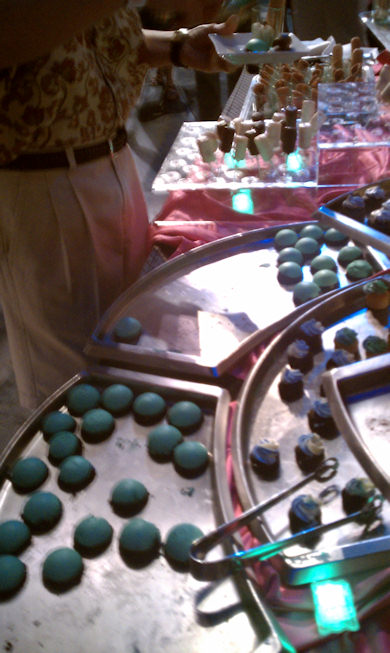
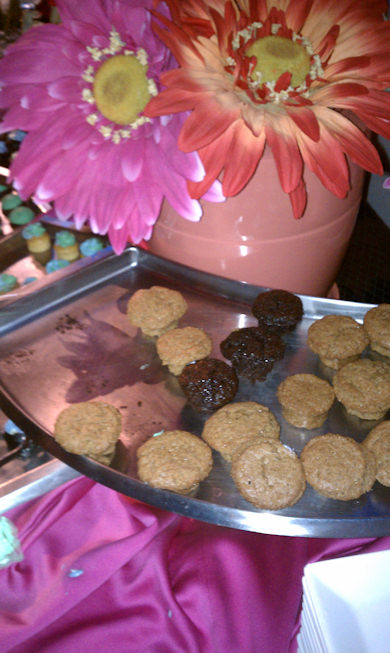
Moving away from the serving table, we found a couple we had shared our dinner table with and settled down next to them. The zebra-dome thingie turned out to be a grasshopper dome, a lovely mint concoction on a chocolate crust base. I was sorry I didn't have more than one of those; my goodness they were delicious. The muffin was fresh and delicious, and the ladyfinger was delightfully light and good. The chocolate coated creation on a stick turned out to be a rolled, creamy icing of some sort that was quite delicious, and I devoured that quickly.
While we were eating, Otto was busy screaming "No pictures" while posing with guests, but he was quickly upstaged by the arrival of the star of the evening - Glinda the Good Witch of the North. Glinda was amazing, pretty and gracious in an unbelievable concoction of shimmering taffeta and silk, she swirled through the tables with grace and ease, waving her blinking wand ahead of her. She was an instant hit, and Everyone (yes, I capitalized that on purpose, because I mean Everyone) wanted a picture with her. The actress was really amazing - she had a gentle grace that really "sold" her part, and her costume was truly spectacular. Someone should turn her loose at a princess meet and greet; I think the little girls would congregate on that dress - Bret certainly did. Eventually, she stepped up on one of the "sidewalks" behind us,and led us in a sing-along with the munchkins which was, of course, interrupted as the Wicked Witch of the West emerged in a plume of smoke. The animatronic was impressive as always, and we had front row seats to the exchange, which was delightful. Glinda boldly delivered the complimenting lines to the figure and vanquished her, then led us in a sing-along with the munchkins. We filed out past the yellow brick road and into the final holding area of the ride.
A lot of the group was slow heading out; they were still taking pictures of Glinda and of the yellow brick road. Otto, who was in the final room kept heckling the people behind us, again shouting "no pictures," and trying to gently move everyone along. Finally, the majority of us arrived in the theater, and Otto instructed some unseen projectionist to "cue the lights." We stood there in the dim twilight, watching the history of film unfold before us on a screen that seemed even larger from a standing vantage point, and then the doors opened, spilling us into the unload area and back out into the humid air of the summer night around 10:15.
The Rock-n-glow dance party was wrapping up, and we paused for a moment, arms around each other, to just enjoy the awesome music. We were delighted to see a lot of young adults (and adults) dancing in front of the stage, and even after park closing, the band seemed to have a decent crowd still fired up. We headed down Hollywood Boulevard to the strains of "We Will Rock You," and climbed into the car to drive home.
Overall, the experience was a wonderful one. I would definitely recommend it to others. If nothing else, the experience of taking one's time walking through the Great Movie Ride is remarkable, especially if you love movies and Disney theming. Furthermore, the opportunity to take one-of-a-kind photos is unmatched. Although the confirmation email said that pictures were allowed "in designated areas," there was no place where we were limited in picture taking. Certainly, Otto gave us constant "no pictures" warnings, but they were obviously intended as sarcasm. The food was wonderful. My main criticism of the night was the passed reception. There were not enough servers or enough hors d'oeuvres to go around. For my husband to get 2 bites and me to get 1 at a "passed reception" seemed rather inadequate. That seemed unfair, and I was a bit resentful of that set-up. Other than that, everything was handled beautifully. I loved the fact that each "stopping point" in our meal had characters and entertainment, and I thought that the whole experience was absolutely delightful.
Wednesday, July 7, 2010
Captain Eo Passholder Preview
I have fond memories of Captain Eo. As a kid, I was definitely not a part of the 80s rock and roll scene, but my mom did love to see Michael Jackson dance, so I was familiar with the phenomenon that was Michael Jackson in the 80s. I loved Captain Eo as a kid at Epcot. Epcot, back in the 80s, was not as much a kid-friendly park as it is today, and Captain Eo was one of those attractions I could go to over and over. I was a child with a passionate love of fantasy growing up in a family that frowned on science fiction and fantasy because of religious conviction. Captain Eo fed my passion for something I didn’t get much of, and I loved it.
So, when 24 years later, I got an email offering a passholder preview of Captain Eo…I begged my husband to go. Honestly, it didn’t take much begging. His memories of the show were as positive as mine, and the timing of the preview was something we could both make work, so off we went through the outer bands of a tropical storm, to see Captain Eo.
After an overly long, harrowing drive through torrential rain and Fourth of July weekend traffic, we arrived on property. We stopped off for dinner at Olivia’s Café at Old Key West, and then turned our tires to Epcot.
The Florida twilight was lying heavy over the Disney landscape as we headed across property, and although there were streaks of color breaking through the clouds, a light drizzle was still falling into the puddles left by the earlier downpour. By the time we left Olivia’s, I was feeling pretty good about the whole thing; we were on time, and I was betting the storms had driven most of the guests out of Epcot, which suited me fine. Sure enough, we rolled through the tollbooths at Epcot around 7:40 without a pause. There were no cast members in any of the booths, and the parking guides were long gone. We rolled right up into the first lot, and found a parking space in the second row of spaces. Climbing out of the car, we headed for the gates, passing droves of poncho-clad visitors with damp hair stuck to their cheeks heading out to the parking lot. We moved quickly through the gates and past the geodesic dome of Spaceship Earth. I was right; although there were still guests moving around, the park was definitely uncrowded, an event especially worthy of note on an EMH night. We had no problem making our way to the Journey into Imagination pavilion. The entire front area was deserted, and we followed the stand-up signs announcing the passholder preview to the left and into the entrance to Captain Eo.
Much to my delight, there was no line. The cast members welcomed us, and we grabbed our 3-D glasses and were ushered down a small ramp into the preshow area.
The pre-show area was a decent sized space with an angled floor. We were told to go as far to the front as we could and then move in toward the center. Banks of video screens were suspended from the ceiling, and when we arrived, they were showing a behind-the-scenes documentary tracing the creation of Captain Eo. They showed set construction, dancer auditions, rehearsal, direction by a very young Steven Spielberg, costuming, and dress rehearsal. The documentary was set to an upbeat 80’s soundtrack that kept the crowd excited, and the monitor on the far right had closed captioning turned on to ensure that anyone with hearing problems could follow the video.
I settled in. The registration email had specified that we had to check in half an hour before our designated show or we would not be allowed in. Sure enough, we had made it to the theater by 7:50, so I figured we’d be ready for our 8:20 reservation. To my surprise, however, a little less than 10 minutes after we arrived, the video ended, and we were directed to stand back from the doors, which would, evidently, be opening toward us. We were getting into the 8:00 showing!
We filed into the theater, fanning out to fill in the rows in the large space. Moving to the end, as directed, we were preparing to settle into our seats when we noticed that the row we had chosen was only perhaps half full, and the guests were congregating in the middle of the row to get better angles for the film. We followed the herd, settling in just to the left of center facing the huge, shimmering Captain Eo logo on the screen.
There was definitely a “vibe” in the theater. We were there to see Captain Eo, and so, it was very clear, was everyone else. There was a sense of excitement and enthusiasm. People were talking about their memories of the film years ago, and a few were singing rather off-key renditions of the songs from the show. At the podium to the front right of the screen, a cast member appeared, welcomed us to the preview, and reminded us that this was the original 70mm 3-D film from 1986 brought back for our enjoyment. The lights dimmed, and, with a healthy dose of hooting, clapping, and foot stamping, we settled in.
The film was a delight. Certainly, the special effects don’t hold up to modern digital photo-realistic standards, but they have the weight, texture, and sense of “reality” that I still contend miniatures bring. It was like seeing Star Wars on a 3-D screen, and the puppet-characters charmed the audience all over again. When Jackson rose onto the bridge, dressed in his padded-shouldered white leather finery, we cheered and clapped…and then as that delicate, high voice intoned “we’re goin’ in” with effeminate intensity, we shared a chuckle.
Overall, the film was a much fun as I remembered. Although the smoke and laser effects of the original show are not included, the designers did an excellent job of using light effects to emulate the laser flashes, and to follow the action on the screen. The flashes and colored lights worked seamlessly with the film, and the moving seats were amazing! Personally, I had expected the seat to move in the way I had experienced in other theaters – the lower portion of the seat would expand or bounce. Instead, everything moved, in a way far more reminiscent of a motion simulator than a moving theater seat. The floor beneath our feet and our seats moved, and the first time we felt the movement with the initial ship crash on screen, I felt the effect was pretty darn amazing.
The remainder of the film was fun and flashy with the childish joy and faith in the triumph of good that I remembered. I was amazed at the almost prescient design work. Considering that the film predated the Star Trek advent of the Borg, the design of Angelica Huston’s costume is prophetic, as are the hybrid creatures that Captain Eo frees from the columns of mechanical detritus along his path. The makeup, costuming, and attitude was definitely 80s, but seeing Jackson at his peak doing the kind of showmanship that earned him his reputation was wonderful. More than that, though, the film brought the idealistic faith in imagination and the triumph of good (not to mention transformative laser blasts) that has been missing from Journey into Imagination for so long.
The film ended, and the audience went crazy. I think if there had been an encore, we would have earned it. Filing out, I didn’t see a face without a wide smile, and conversations ranged from comments about how the film was better than remembered to laughter and enjoyment from those who had never seen the film except on YouTube.
As we swirled out onto the pavement, moving through the rising dusk in front of the leapfrog fountain, we brought with us laughter and hope. Maybe it was nostalgia, but there was more than that. There was a sense of fun, and smiles bright enough to cut through the rain.
Subscribe to:
Posts (Atom)







